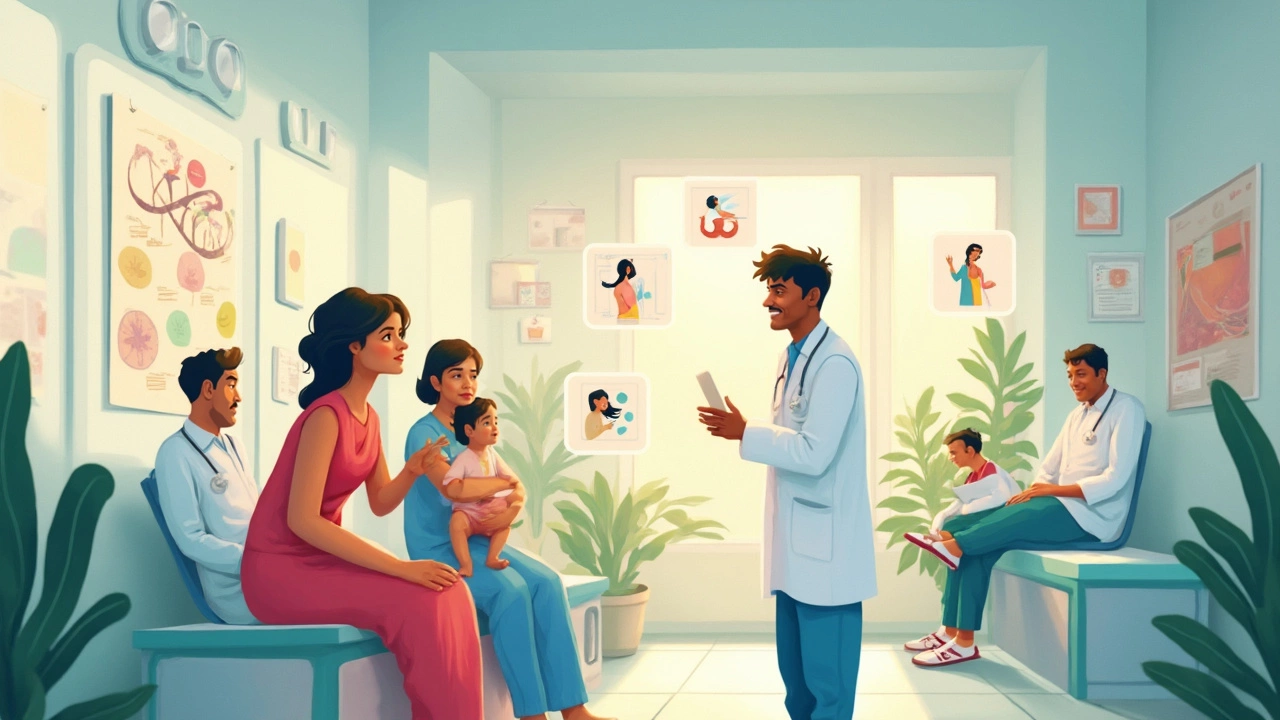People usually think cancer always hurts, but that’s not how it works. A lot of folks with early cancer don’t feel any pain at all. In fact, pain often shows up only once the disease moves along or messes with certain nerves or organs. You can actually have cancer growing quietly for months—or even years—before anything hurts.
Why does this matter? Because pain isn’t a reliable sign you have cancer, and not having pain doesn’t mean you’re in the clear either. Learning how cancer pain behaves at each stage can help you worry less and spot problems sooner. This isn’t just about catching cancer early, but also about knowing what to expect if you—or someone close—has a diagnosis and wants to prepare.
- Cancer Pain: Is It Always There?
- Why Stage Matters for Pain
- Types of Cancer Pain and Where It Shows Up
- Managing Pain: Real-World Tips
- What Doctors and Patients Often Miss
Cancer Pain: Is It Always There?
Here’s something that throws a lot of people off: just because you have cancer doesn’t mean you’re automatically in pain. Most early-stage cancers sneak up with barely any symptoms at all, pain included. You could have something small like a tumor forming, and have no clue because it’s not pressing on nerves or causing swelling.
The type of cancer matters a lot. For example, slow-growing cancers like some prostate or thyroid cancers may not hurt at all in the beginning—even for years. On the other hand, cancers that start in places with a lot of sensitive tissue, like pancreatic cancer or bone cancer, are more likely to hurt sooner. Still, even with these, pain comes and goes for a while before it sticks around.
Surprisingly, studies from places like the American Cancer Society show that less than a third of folks with early cancer report any pain. For many, pain is what finally leads them to see a doctor. But for a big chunk of patients, they only start feeling discomfort much later, when the tumor has either grown or spread to new spots in the body.
Just because you feel pain somewhere doesn’t mean you have cancer—plenty of things can cause everyday aches. Same goes if you don’t feel pain; it doesn’t always mean you’re safe. The cancer pain puzzle is trickier than people think. If you’re stressed about a strange pain, don’t jump to the worst-case scenario, but don’t ignore it for months either. Doctors say that if you’ve got pain that won’t quit for a couple of weeks—especially if you can’t explain it—you should get it checked out.
Why Stage Matters for Pain
Let’s break it down: the stage of cancer you’re dealing with makes a huge difference in how likely pain is to show up. In the early stages—think Stage 1 or 2—cancer usually hasn’t spread much. It sticks to one spot and might be too small to bother nearby nerves, bones, or organs. That’s a big reason why so many people with early cancer—like breast or prostate cancer—don’t feel anything weird at all. It’s not that their bodies have superpowers. It’s just that the tumor isn’t big enough or in a spot that hurts yet.
Now, things start changing fast in Stage 3 and Stage 4. At this point, cancer cells might be pushing into other tissues or even traveling far from where they started. When that happens, pain is way more common. For instance, cancer that spreads to the bones can cause deep aches that just won’t quit. When a tumor presses against nerves, it can lead to burning pain, numbness, or weird tingling, depending on what it’s squishing.
Most folks with late-stage cancers deal with some level of pain, and sometimes it’s the main reason they end up at the doctor. This is especially true for cancers like pancreatic or lung cancer, where pain may show up earlier because of where these organs are or how quickly the tumor grows. The type and amount of pain really depends on the cancer’s location, size, and what it’s bumping into or invading.
Here’s a quick breakdown of what might happen at different stages:
- Stage 1: Rarely painful, cancer is usually small and localized.
- Stage 2: You might feel mild discomfort, but pain is still pretty uncommon.
- Stage 3: Tumors often grow larger or start spreading to nearby tissues, so pain can start to become noticeable.
- Stage 4: Pain is much more likely because cancer spreads (metastasizes) and can affect bones, nerves, or organs.
The big takeaway? Pain usually lines up with how advanced the cancer is, but not always. That’s why paying attention to other symptoms and not ignoring changes in your body matters—even if everything feels okay. The cancer pain you hear about most is often from cancers at later stages, not the beginning.

Types of Cancer Pain and Where It Shows Up
Cancer pain isn’t one-size-fits-all. It changes depending on the type of cancer, its location, and which body parts it starts to push on or damage. Here’s what’s actually going on when people talk about cancer pain.
You’ll see three main types:
- Nerve pain (neuropathic pain): This usually happens when a tumor presses on nerves or the spinal cord. It can cause tingling, numbness, burning, or even sharp jabbing pains. People sometimes mistake it for what you feel with sciatica or pinched nerves—for example, pain that shoots down your arm or leg.
- Bone pain: When cancer spreads to bone or starts there, it can feel deep and aching. It might get worse at night or when you’re moving around. Bone pain is actually one of the most common reasons folks with advanced cancer feel uncomfortable, especially with cancers like breast, prostate, or lung that spread to bones a lot.
- Organ pain: If cancer locks onto organs like the liver, pancreas, or colon, people often describe a constant, dull ache. Sometimes it shows up as cramping or bloating. As tumors grow, they can stretch the organ’s covering or block passages, which leads to all kinds of soreness or pressure—like feeling way too full after a small meal.
Where the pain shows up depends a lot on the primary cancer and where it’s moved. For instance:
- If you have lung cancer, you might get chest pain, shoulder pain, or pain that feels sort of like a pulled muscle, because tumors press on nearby nerves or tissues.
- Liver or pancreatic cancer pain often lands in the upper belly or even goes through to the back.
- Head and neck cancers can make swallowing pure agony or trigger ear pain, even if the ears are fine.
One thing people don’t expect: sometimes you feel pain in places that seem unrelated. That’s because nerves branch out in unpredictable ways or tumors press where you don’t expect. If there’s ever a sudden, unexplained pain that sticks around—especially if you have other symptoms—it’s wise to talk to your doctor.
The most important thing about cancer pain is that it’s not always “bad pain” right away. Sometimes it’s barely there, sometimes it comes and goes, and sometimes it’s stubborn and constant. Knowing the types and where they might show up helps you spot changes early and work with your care team to stay comfortable.
Managing Pain: Real-World Tips
Let’s talk about things that actually help when cancer pain shows up. First off, pain is different for everyone, but you don’t have to tough it out or just hope it goes away. There’s solid science on what works, and you can mix approaches to fit what you need.
Doctors usually go for a step-by-step plan, sometimes called the "pain ladder." You start simple and only go stronger if you really need it. Here’s how most manage it:
- Over-the-counter pills (like acetaminophen or ibuprofen) are enough for a lot of people with mild pain. Don’t be afraid to ask about them if your pain is just starting.
- If pain gets worse, doctors might use prescription meds, including opioids. Don’t worry—when these are used right, they help more than they cause problems, especially in cancer treatment.
- Other options are nerve blocks, patches, or even low doses of antidepressants—not because you’re sad, but because they calm nerve pain.
There’s also a bunch of ways to help your pain that aren’t just about pills. Try these if you haven’t already:
- Physical therapy and gentle exercise (think stretching, easy walks, or light yoga)
- Heat packs or ice packs for local pain
- Massage, if your doc says it’s safe for you
- Mind tricks—stuff like mindfulness or distraction really works for some
| Pain Relief Method | Chance of Helping | Notes |
|---|---|---|
| Acetaminophen/Ibuprofen | 60-70% | Best for mild pain, watch your dose |
| Prescription opioids | 70-85% | Works for moderate to heavy pain |
| Physical therapy | 50-75% | Helps with aches, muscle pain |
| Mindfulness/Relaxation | 30-60% | Mix with other methods |
If you’re still hurting, keep your care team updated. Sometimes pain means something’s changed, or another treatment might help more. There’s no award for “toughing it out”—addressing pain early means you enjoy life more and can actually stick with your main treatment plan.
One more thing: don’t let worry about addiction or side effects drive you. Meds for cancer pain are safe when used as directed. Lots of folks, including me and my wife Ananya, have learned that staying on top of symptoms makes the whole journey easier. Listen to your body and speak up if things don’t feel right.

What Doctors and Patients Often Miss
Here’s a weird truth: a lot of people—both in white coats and hospital gowns—expect cancer pain to follow a set pattern. But it rarely does. One of the biggest things missed is that pain isn’t always tied directly to the cancer pain itself. Sometimes, pain comes from stuff like treatment side effects, infections, or even anxiety about what’s going on.
Another thing? Doctors sometimes underplay pain—assuming anyone in early stages shouldn’t feel much. But pain can show up early if a tumor presses on nerves or sensitive spots, even when the cancer hasn’t spread. On the flip side, some patients stay quiet about pain, thinking it’s “normal” or not wanting to bother their doctor. Honestly, both sides can drop the ball here.
Here's a quick look at some common overlooked facts:
- Pain can be unpredictable. Don’t assume you’re fine just because you don’t hurt, and don’t panic if you do.
- Cancer treatments (like chemo or radiation) sometimes cause their own types of pain. Nerve pain, mouth sores, and joint aches can all be linked to treatment—not just the disease.
- Emotional stress messes with pain. Anxiety or depression can actually make pain feel worse or appear when you didn’t have it before.
- Communication is key. Honest talks about pain help your medical team tweak your meds, switch up treatments, or send you to a pain specialist if needed.
Let’s slap some numbers on this. Around 55% of people with cancer experience pain at some point, but in advanced cancer, that number jumps closer to 80%. Yet surveys have shown that more than 35% of patients hesitate to mention pain until it’s really severe.
| Stage | Approx. % of Patients Reporting Pain |
|---|---|
| Early | 30% |
| Mid | 55% |
| Advanced | 80% |
The lesson? Don’t play guessing games. You know your body way better than anyone else. If something feels off—even if doctors said pain shouldn’t happen—bring it up. Patients who speak up early often get help faster, take fewer pain meds long-term, and have a better shot at a decent quality of life. Don’t just tough it out. There are always ways to tackle pain once everyone’s on the same page.



